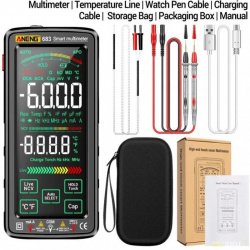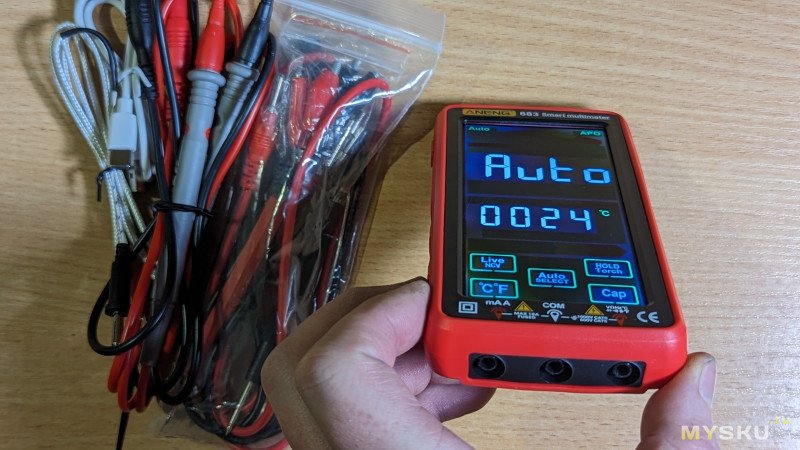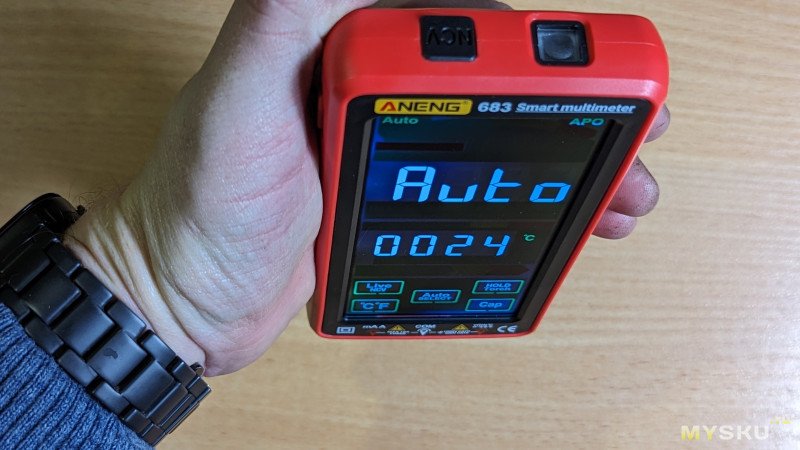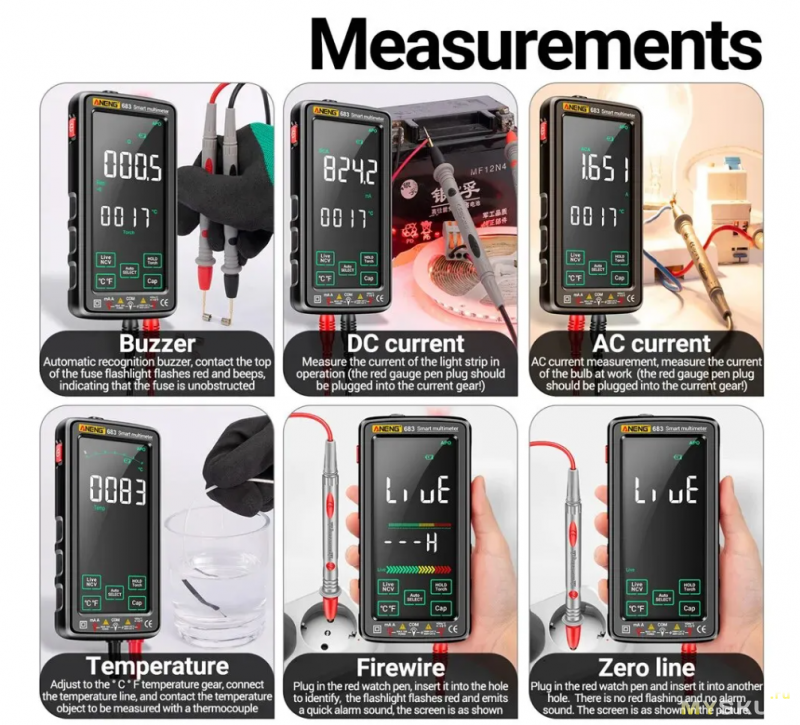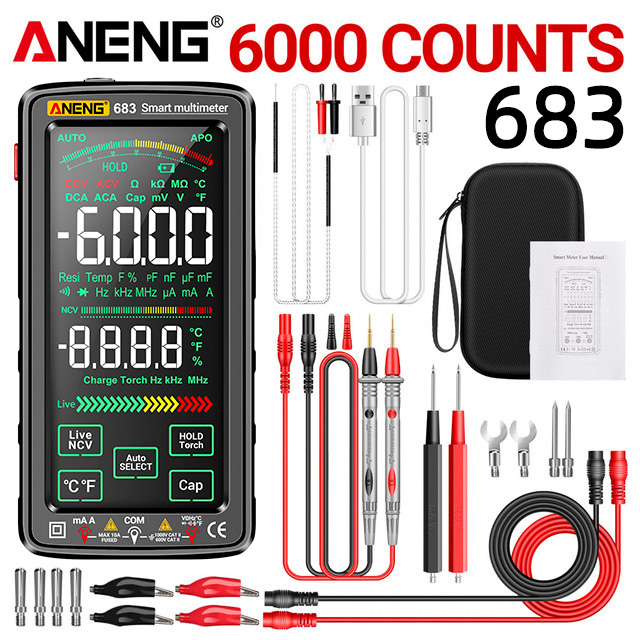- Цена: 18.77$
- Перейти в магазин
Увидел на Али такой мультиметр, и сразу захотелось себе 
Яркий, крупные символы, автоматический выбор режимов измерения…
Ну, по порядку.
Прибор относительно новый в продаже, потому немного порыскав нашёл оптимальную стоимость на него. Заказал, через 20 дней забрал в почтовом отделении. Поставляется в картонной коробке, в которой лежит мягкий бокс на молнии (собственно, классическая сумка у китайцев)
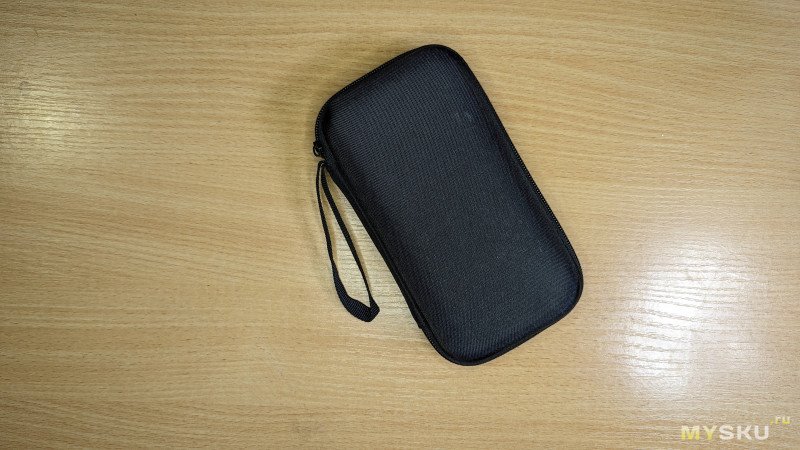
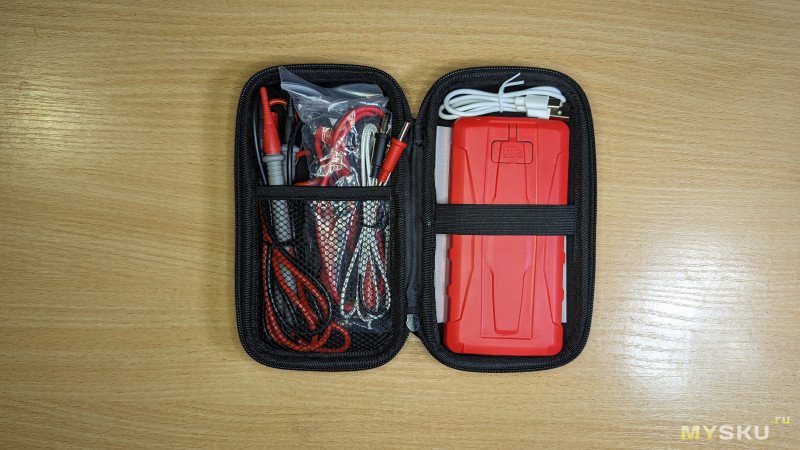
В сумке оказалась две пары щупов, термопара, зарядный кабель USB Type-C, инструкция и сам мультиметр
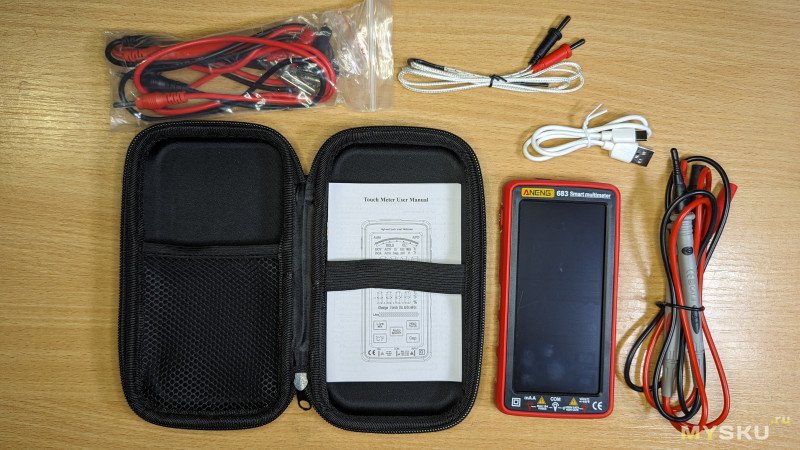
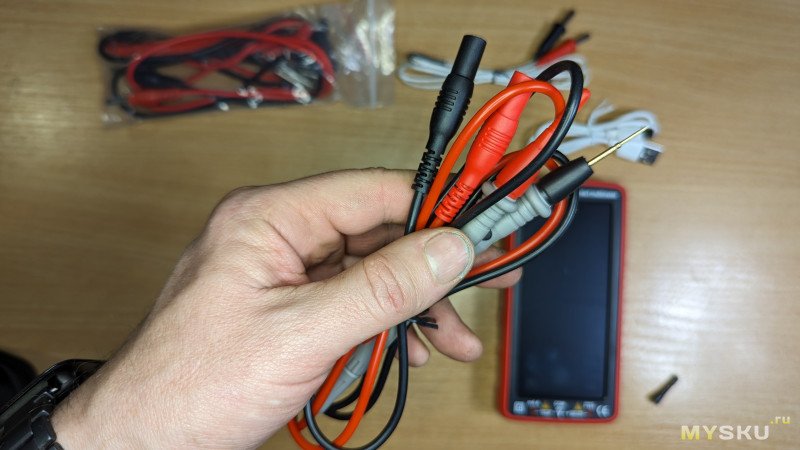
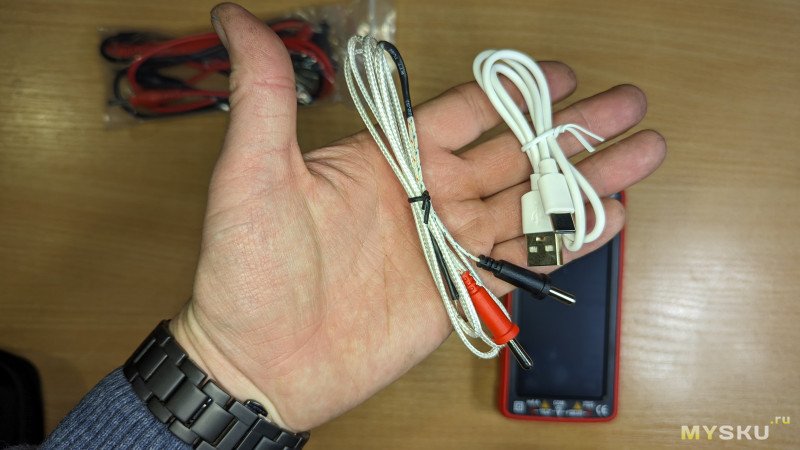
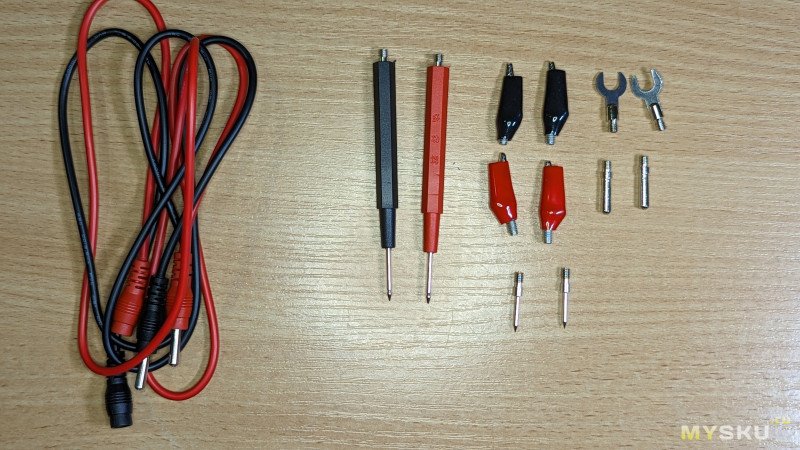
Сам мультиметр с левой стороны имеет одну кнопку включения, с правой стороны места в корпусе под физические кнопки 681 модели. Корпуса одинаковые видимо. Сверху окно фонарика/сигнального светодиода и датчик NCV модуля


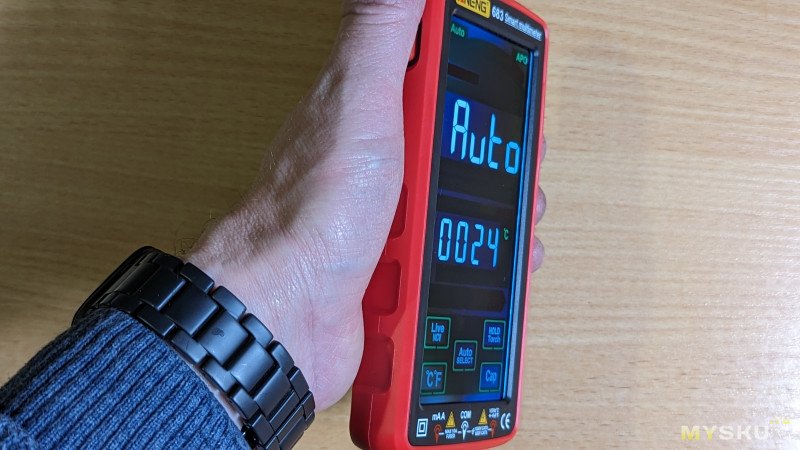



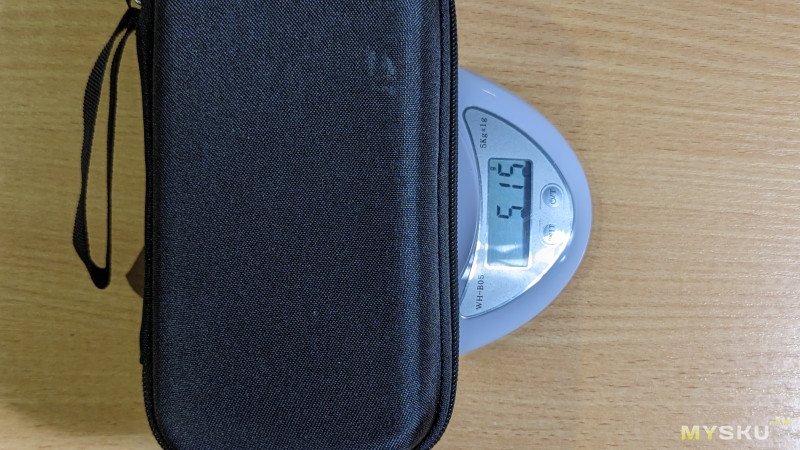


Почему я написал, что это прибор для новичков?
Измерения у него достаточно точны, диапазон напряжений и тока тоже на уровне: 1000V DC и 750V AC с максимальным током 10А
Да и радио компоненты меряет достаточно точно, проверил
Просто он очень понятный без инструкций. Почти все измерения выполняет в автоматическом режиме. Интерфейс юзер френдли, я бы сказал.
Тем более, за более чем доступную стоимость.
Ну а видео обзор комплектации, тестирования прибора — здесь:
Планирую купить
+8
Добавить в избранное
Обзор понравился
+24
+37
Функции:
Многофункциональный тестер: включая функции измерения переменного/постоянного напряжения, переменного/постоянного тока, сопротивления, емкости, температуры, частоты, диода, зуммера, линии нулевого огня, рабочего цикла и т. д.
Сенсорный экран и ЖК-дисплей VA Цветной обратный дисплей: интеллектуальный сенсорный экран, прост в эксплуатации. Цветной обратный дисплей VA и макс. 6000 отсчетов. дисплей с функцией удержания данных, четкий для чтения измеренного значения в различных рабочих условиях.
Бесконтактная индукция NCV: используйте датчик NCV, чтобы определить, чем ближе к источнику питания, тем быстрее срабатывает сигнал тревоги, а фонарик мигает красным.
Фонарик, освещающий фронт: в темноте вы больше не боитесь не увидеть измеренное положение, это хороший помощник в ночной работе.
Мягкая силиконовая проволока: высококачественная тестовая проволока устойчива к растяжению и высокой температуре, обладает защитой от замерзания и возгорания.
Встроенная перезаряжаемая литиевая батарея: не нужно снова покупать и заменять батареи, оснащена кабелем типа C для зарядки, безопаснее и удобнее.
Силиконовый защитный чехол: обернут силиконовым защитным чехлом, чтобы эффективно предотвратить падение и защитить мультиметр от повреждений. Ударопрочность и устойчивость к царапинам.
Технические характеристики:
Напряжение переменного тока: 0-750 В
Напряжение постоянного тока: 0-1000 В
Ток переменного тока: 0 мА-10А
Ток постоянного тока: 0 мА-10А
Сопротивление: 0 Ом-60 МОм
Емкость: 0нФ-100мФ
Гц: 0 Гц-999,9 кГц
Температура: -40~1000℃ / -40~1832℉
Индукция NCV: Да
Нулевая линия огня: Да
Рабочий цикл%: Да
Зуммер: Да
Диод: Да
Фонарик: Да
Автоматическое отключение питания: Да
Удержание данных: Да
Индикация низкого заряда батареи: Да
Цвет: черный/красный (опционально)
Материал: АБС+силикон
Макс. Количество: 6000 отсчетов
Дисплей: цветной дисплей VA
Экран: сенсорный экран
Встроенная батарея: литиевая батарея 3,7 В 2800 мАч
Размер изделия: 152*76*25 мм/5,98*2,99*0,98 дюйма
Вес изделия: 217 г/7,65 унций
Вес упаковки: 472 г/16,23 унции
Размер упаковки: 20,6*11*5,5 см/8,11*4,33*2,17 дюйма
Список пакетов:
1 * мультиметр
1 * термопара
1 * зарядный кабель
1 * пара тестовых проводов
1 * сумка для хранения
1 * Руководство (на английском языке)
Мультиметр Aneng 683
Устройство представляет собой цифровой мультиметр со стабильной производительностью и надежным качеством.
Он может использоваться для измерения напряжения постоянного тока, синусоидального RMS напряжения переменного тока, тока постоянного тока, синусоидального RMS тока переменного тока, сопротивления, емкости и т.д.
Этот прибор оснащен аккумулятором высокой емкости, полностью функциональным и точным измерением. Универсальный прибор является идеальным инструментом для лабораторий, заводов, радиолюбителей и домашних хозяйств.
Характеристики:
Умный цифровой мультиметр
Материал: ABS — пластики
Питание: встроенный 3,7 В 2800 мАч полимерный литиевый аккумулятор
Напряжение постоянного тока 0 В ~ 1000 В 0001 В ~ 1 В ± (0,8 0)
Напряжение переменного тока 0 В ~ 750 В 0001 В ~ 1 В ± (1,0 0)
Измерение переменного тока 0 мА ~ 10 А 1 мА ~ 0,01 А ± (2,5 0)
Измерение постоянного тока 0 мА ~ 10 А 1 мА ~ 0,01 А ± (2,5 0)
Измерение сопротивления 600 Ом / 6k Ом / 60k Ом / 600k Ом 0,1 Ом / 001k Ом / 0.1k Ом + — (0,8% + 3 цифры)
6M Омега 0001M Омега + — (1,2% показания + 3 цифры)
60 Mомега 0,01Mомега + — (2,5% показания + 5 цифр)
Измерение ёмкости 60nF / 60nF / 6uF / 60uF / 600uF / 6mF 0,01 nF / 0.1nF / 0.1nF / 0.001uF / — (4,0% показаний + 20 бит)
60mF 0,01 mF + / — (5,0% показания + 5 цифр) 100mF 0.1mF
Измерение частоты 9.999Hz / 99.999Hz / 999.9Hz 0001Hz / 001Hz / 01Hz / 01Hz + / — (0,8% показаний + 3 цифры)
9.999kHz / 99.99 kHz / 999.9kHz 0001kHz / 0.01kHz / 0.1kHz / 0.1kHz + / — (0,8% показания + 3 цифры)
Измерение температуры — 40°C — 300°C + — (1,0% + 4d) 1°C
301°C — 10000°C + — (1,9% + 5d) 1°C
— 40°F — 600°F + — (1,2% + 6d) 1°F
601° F — 1832° F + — (1,9% + 6d) 1°F
Тест на диод есть
Хранение данных автоматическое
тест NCV есть
Прозвонка цепи есть
Размер: около 15,2 x 7,6 x 2,5 см
Цвет: красный
Комплектация:
Цифровой мультиметр, термопара, USB Type-C кабель для зарядки, сумка для хранения, руководство пользователя
(Published on 26/06/2023)

|
Aneng’s Model 683 belongs to the very latest generation of handheld multimeters that completely resemble a smartphone and are operated in the same way via the touch-screen. |
Introduction to model 683 from Aneng
Type, manufacturer and prices
Almost all Chinese mail order companies offer this multimeter as ‘model 683‘ of the Aneng brand. Prices range around thirty euros. At the time of this test, you paid € 26.30 for it at Banggood and € 26.44 at the cheapest provider on AliExpress. Our sample was provided free of charge for a test by Banggood.
The main features of the Aneng-683
The distinguishing feature of this multimeter is that it is equipped with a touch screen as large as a smartphone, so the five control buttons are not present as such, but as on-screen icons. The device looks completely like your phone, the only obvious difference is that this meter is much thicker than a phone.
The display contains the standard two numeric and one analog displays. The numeric displays have four digits and have a display range up to 5999, except for measuring frequencies where the range is extended to 9999.
The meter is powered from a built-in 3.7 V lithium battery with a capacity of 2,800 mAh. You can charge this battery via a USB-C connector on the back from a standard 5 V adapter. This connector is behind a splash-proof cover.
The meter is called ‘smart‘ because it can determine what you want to measure. A nice advertising slogan, but not entirely accurate. It automatically switches between resistance, voltage and current, but for measuring capacitors, frequencies and temperatures you still have to intervene. Of course, the range is also selected automatically, which you can’t even choose manually.
The meter comes in a red or black rubber protective case and with a handy carrying case.
 |
| The front and back of the Aneng 683 multimeter. (© 2023 Jos Verstraten) |
Aneng’s Model 683 viewed from all sides
The picture below shows the five main views of this multimeter. On the top is a white LED and the location of the ‘NCV‘ sensor is indicated by a pictogram. This sensor allows you to detect voltage carrying wires in the wall. In the bottom, you can see the three sockets for 4 mm banana plugs labeled ‘mA/A‘, ‘COM‘ and ‘V/Ohm/°C/F‘. On the left side is a red push button to turn the device on and off.
The display shows all indications that, in one combination or another, may appear on the screen. The five touch buttons are shown in a green frame:
- Live/NCV:
Function for detecting the live wire in wall outlets and voltage carrying wires in the wall. - °C/°F:
Function for measuring temperatures in °C or °F with the supplied thermocouple. - Auto/SELECT:
- Allows you to disable the smart function and select the desired measurement function by key presses.
- HOLD/Torch:
Freezes the measured value on the display and turns the white LED on or off. - Cap:
Function for measuring capacitors.
 |
| Five views of the multimeter 683 from Aneng. (© 2023 Jos Verstraten) |
The scope of delivery
The multimeter comes in an unbranded cardboard box containing:
— The meter itself.
— A handy carrying case.
— A rubber protective cover, red or black of your choice.
— The two well-known Chinese test leads of one meter length.
— A very inexpensive one-meter thermocouple lead.
— A USB-C to USB-A charging cable of 45 cm.
— A miniature manual in Chinese and English.
On the product page of some vendors, including Banggood, there is a picture promising a lot of things that were not in the package! These include four crocodile clips, two extension cords, two extra measuring pens and some other little frills. There is no way those fit into the cardboard box, let alone the carrying case that crams all the attributes! So this photo is misleading and shows something that is not delivered!
 |
| The scope of delivery of our Aneng-683 multimeter. (© 2023 Jos Verstraten) |
The manual
We have scanned the English version of this booklet and saved it for you on our account on archive.org:
The specifications of the 683 from Aneng
According to the manufacturer, this multimeter has the following specifications:
— Display numeric: 2 x up to 5999 counts or 9999 counts
— Display analog: 1 x bargraph with 60 segments
— Sampling: 3 samples/s
— Measuring ranges DC voltage: 6 V ~ 60 V ~ 600 V ~ 1,000 V
— Accuracy DC voltage: ±(0.5 % + 3) ~ ±(0.8 % + 10)
— Measuring ranges AC voltage: 6 V ~ 60 V ~ 600 V ~ 750 V
— AC voltage accuracy: ±(0.8 % + 3) ~ ±(1.0 % + 10)
— Measurement principle of AC voltage: RMS
— AC voltage frequency range: 50 Hz ~ 1 kHz
— Input sensitivity voltage measurement: 0.8 V
— Input resistance voltage measurement: 10 MΩ
— Measuring range DC current: 600 mA ~ 10 A
— Accuracy DC current: ±(1.0 % + 5) ~ ±(2.5 % + 10)
— Measuring range AC current: 600 mA ~ 10 A
— Accuracy of AC current: ±(1.0 % + 5) ~ ±(2.5 % + 10)
— Protection of current measurement: 20 A glass fuse
— Resistance measurement ranges: 600 Ω ~ 6 kΩ ~ 60 kΩ ~ 600 kΩ ~ 6 MΩ ~ 60 MΩ
— Resistance accuracy: ±(0.8 % + 3) ~ ±(2.5 % + 5)
— Measuring ranges capacitor: 60 nF ~ 600 nF ~ 6 μF ~ 60 μF ~ 600μF
— Measuring ranges capacitor: 6 mF ~ 60 mF
— Accuracy capacitor: ±(4.0 % + 20) ~ ±(5.0 % + 5)
— Conductance voltage diode measuring range: 3.2 V
— Measuring current through diode: 1 mA
— Limit value of conductivity measurement: 50 Ω
— Open circuit voltage conductivity measurement: 1.0 V
— Measuring range frequency: 10 Hz ~ 100 Hz ~ 1,000 Hz ~ 10 kHz
— Measuring range frequency: 100 kHz ~ 1,000 kHz
— Accuracy frequency: ±(0.8% + 3)
— Measuring range temperature: -40 °C ~ +300 °C
— Temperature accuracy: ±(1.0% + 4)
— Power off time: 15 min
— Voltage protection input: 1 kVdc or 750 Vac
— Power supply: 3.7 V ~ 2,800 mAh lithium battery
— Dimensions: 150 mm x 75 mm x 24 mm
— Weight: 180 g
The electronics in the Aneng-683
Opening the case
After removing the rubber protective cover, you will find that the two parts of the housing are connected by only four small screws. After removing these screws, you can open the multimeter like the two half shells of an oyster. One ‘shell‘ contains the lithium battery, and the other ‘shell’ is completely filled with the PCB. There are only four wires in sight. Two connect the battery to the PCB, the other two go to the backlight plate that sits behind the display.
 |
| Inside the Aneng-683 multimeter. (© 2023 Jos Verstraten) |
The PCB in detail
The PCB is attached to the housing with six miniature screws. Under the PCB is the backlight plate of the display and the display itself. The connections between the PCB and the display are made with conductive rubber contact strips.
We provide some details about the electronics on this PCB presented in the photo below. On the top right you can see the 4 mm socket ‘mA/A‘ for the current input. This is divided into two parts that make contact the moment you insert a banana plug into the input. This way, the meter knows you want to measure a current and the electronics automatically enable this measurement function. You can see that a standard 5 mm by 20 mm fuse is placed on the PCB. It is worth noting that the left fuse holder can be soldered slightly to the left. The fuse can then be replaced by a 6.3 mm by 25 mm fuse. These have a higher voltage range of 250 V and in addition, you can obtain the much better HRC types in this range of fuses. Also, the current sensor resistor R12, now implemented as an SMD resistor, can be replaced with a larger non-SMD one. Apparently, the PCB is designed for both a cheap model of multimeter and a slightly more expensive model that better meets international specifications in terms of protection class and protection.
Below the lower socket ‘V/Ohm/°C/F‘ you can see the two MELF resistors R6 and R6A of 5 MΩ that would fix the input resistance when measuring voltages to the specified 10 MΩ. However, also connected to this input socket is a series circuit of three SMD resistors R9A, R9B and R9C of 300 kΩ. There is no way to figure out where this circuit goes, but it is clear that this 900 kΩ connected to the input raises doubts about the specified input resistance of 10 MΩ. We shall see!
The protection is standard with a PTC, the green part, and two transistors to the left of the MELF resistors.
 |
| The PCB of the Aneng-683 multimeter. (© 2023 Jos Verstraten) |
On the top left, you can see the power switch with U4, an AiP16C23 chip, below it. That’s an LCD controller from Wuxi I-CORE Electronics that controls traffic to and from the display. To the left of this chip, a metal plate protrudes a few millimeters from the PCB. That is the ‘sensor‘ that is supposed to pick up the 50 Hz electromagnetic field present around voltage carrying lines in the wall.
To the right of the USB-C connector is U3, an SMD chip labeled 57cL. That appears to be the SMD version of the CL4057A, a lithium battery charger and controller. Above the 4 MHz crystal is U2, an HE24C02. That’s a 2 kb serial EPROM from HuaHong ZealCore. This is probably where the multimeter’s individual calibration values are stored. In the center of the PCB is an unrecognizable chip U6. This will no doubt be a dual ADC that takes care of the entire control and execution of the various measurement functions. Further to the right is another 16-pin chip U5, also made unidentifiable. Next to this chip are a lot of resistors and it is obvious that this IC is a CMOS switch that plays an important role in automatically selecting the best measurement range.
Testing the Aneng Model 683
Introductory note
In the following tables, adjustment values of a voltage or current source are listed in the leftmost column. You should not regard these as absolutely accurate and thus not use them to judge the accuracy of the Aneng-683. That is what the right-hand columns with comparative measurements with our much better laboratory equipment are for.
Measuring DC voltages
Here we use our NPS-1601 power supply as the source. To measure 50 V, it is connected in series with a GVDA power supply. The results are summarized in the table below. This shows that the Aneng-683 gives almost the same readouts as our Fluke 8842A. Neat! The only weakness of the meter in these measurements is that voltages smaller than about 0.4 V are not recognized by the automatic measurement system and the display claims that a resistor is connected to the inputs.
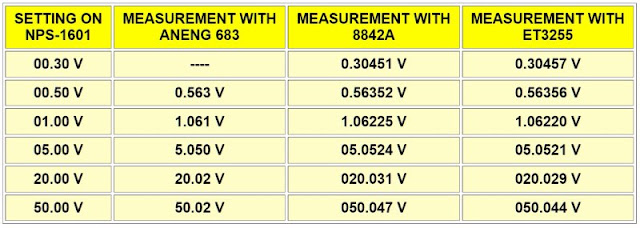 |
| Accuracy in DC voltage measurements. (© 2023 Jos Verstraten) |
Determining the input resistance
When discussing the electronics, we already wrote down our doubts about the specified input resistance of 10 MΩ. The three resistors of 300 kΩ going somewhere from the input socket suggest that this value might be over-specified. To check this, we measure a DC voltage with and without a series resistor of 1 MΩ. Without this resistor, the Aneng-683 measures a voltage of 16.37 V. With the resistor in series, the measured value drops to 7.39 V! That could never happen if the input resistance were equal to 10 MΩ. A simple calculation shows that the real input resistance of the meter is only 822 kΩ! Repeating this measurement with voltages of about 30 V and 2 V yields the same results: 821 kΩ and 827 kΩ.
An input resistance of less than 1 MΩ is out of date and far too low even for this digital meter with a resolution of only 1 mV or 10 mV.
Measuring 50 Hz AC voltages
We use a variac connected to the mains voltage. In this way we can also assess the upper range of 600 V. Note that the data in the first column are the voltages displayed on the small analog meter on the variac and are very inaccurate guide values.
 |
| Accuracy in 50 Hz AC voltage measurements. (© 2023 Jos Verstraten) |
Measuring 1 kHz AC voltages
Modern multimeters have such a wide frequency range that they are also useful for measuring small signal voltages, for example in audio amplifiers. So we generate some small AC voltages with a frequency of 1 kHz with our function generator DG1022 and measure them with the Aneng-683 and with our ET3255. For small voltages, the Aneng-683 fails again. Only at half a volt a reliable stable result appears on the display. Again a consequence of the so-called ‘smart‘ function?
 |
| The accuracy at 1 kHz AC voltage measurements. (© 2023 Jos Verstraten) |
Measuring DC currents
We build a series circuit of a DC power supply, some resistors, the Aneng-683 and the ET3255. By varying the output voltage of the power supply and switching the resistors on and off, we apply eight currents with target values from 1 mA to 5 A to the circuit. The measurement results are again summarized in the table below. Again, the Aneng-683 fails to measure small values.
 |
| Accuracy in direct current measurements. (© 2023 Jos Verstraten) |
Measuring resistors
For this test we have at our disposal a set of resistors with a tolerance of ±0.1 %. As reference meters we obviously use our 8842A from Fluke and our ET3255 from East Tester. These meters use a four-wire kelvin probe, which is not possible with the Aneng-683. The results are again summarized in a table.
 |
| The accuracy in resistance measurements. (© 2023 Jos Verstraten) |
Measuring capacitors
Thanks to a set of five accurate capacitors with a tolerance of ±1 %, we can also determine the accuracy of the Aneng-683 when measuring capacitors. Above 1 μF, we measure ordinary electrolytics from our stock. As a reference meter we use East Tester’s ET4401 with an accuracy of ±0.2%.
As could be expected, large errors arise when measuring electrolytics. This is a consequence of the fact that when measuring capacitors with multimeters, a constant current is passed through the capacitor and measured how long it takes until the discharged capacitor is charged to a certain voltage. That charging time is directly proportional to the capacitance of the component. However, this method does not take into account the leakage current of an electrolytic capacitor that consumes part of the charging current. As a result, the component takes longer to charge and the meter measures a larger capacitance than intended.

Some electrolytics have a large leakage current and the capacitance of such an electrolytic is measured with an error that can be tens of percent. A true RLC meter, such as East Tester’s ET4401, measures the capacitance of the electrolytic capacitor by applying a small 120 Hz sine wave on a DC voltage across the capacitor and measuring the alternating current through the part.
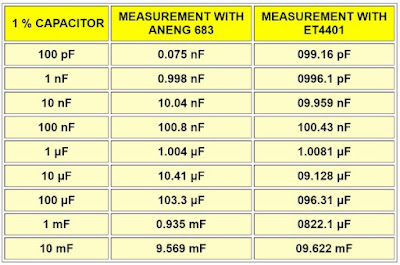 |
| The accuracy in capacitor measurements. (© 2023 Jos Verstraten) |
Measuring frequencies
As a source, we use Rigol’s DG1022 function generator, set to sinusoidal output. We immediately determine the sensitivity, the voltage at which the Aneng-683 measures a stable frequency. We read that as an rms value on the display of the function generator.
 |
| The accuracy in frequency measurements. (© 2023 Jos Verstraten) |
Measuring temperatures
Testing accuracy when measuring temperatures is a tricky business. After all, that accuracy depends not only on the meter itself, but also on the applied thermocouple and the way the temperature is measured. We have a UT320A thermometer from UNI-T with its own thermocouple. The accuracy of this meter is specified as ±(0.5% + 1), that of the supplied thermocouple ± 2 °C.
We cool a large heat sink and a 100 W wire-wound resistor in the freezer. We clamp the tips of the two thermocouples, lubricated with cooling paste, close together between the heatsink and the 100 W resistor. In this way, the two thermocouples become equally hot with high probability. The 100 W resistor is heated via a power supply. We note the reading on the Aneng-683 at the time the UT320A indicates a multiples of ten temperature. The results are again summarized in the table below. The measured temperatures are, miraculously, almost identical!
 |
| The accuracy in temperature measurements. (© 2023 Jos Verstraten) |
The ‘Live‘ and ‘NCV‘ functions
We are never very happy about these functions that every modern multimeter has. This is also the case with the Aneng-683. The sensitivity in detecting voltage carrying wires in the wall is not very high and the positioning is not very accurate. Detecting the live in a wall outlet does work well, but we still prefer the old-fashioned voltage detector with neon lamp and series resistor.
In the picture below you can see, from left to right:
— The display in ‘NCV’ mode when detecting voltage carrying lines in the wall.
— The display in the ‘Live‘ mode when measuring a live contact.
— The display in the ‘Live‘ function when measuring a neutral contact.
 |
| The display in ‘NCV’ and ‘Life’ measurements. (© 2023 Jos Verstraten) |
Our opinion on the Aneng-683
We have mixed feelings about this multimeter. The device looks modern and will no doubt appeal to a youthful audience, raised with the smartphone stuck in the hand. That what the meter can measure it mostly measures accurately, as evidenced by the various tables in our test. However, that the Aneng-683 is unable to measure small voltages or currents is such a major drawback that we would never purchase this instrument ourselves.
About the display nothing but good, large, well lit and thus easy to read.
We assume that the dramatically low input resistance of less than 1 MΩ is a result of the automatic switching, the so praised smartness of this meter. If that is indeed the case, we find this ‘smart‘ feature to be a disadvantage rather than an advantage. It may be due to our age, but we still prefer a multimeter where the user has to manually set the measurement function. Constantly jumping to ‘ohm’ in the automatic measuring function if you do not measure voltage for a moment becomes irritating after a while.
(Banggood sponsor ad)
Aneng model 683 smart multimeter
Доставка
Общее расчетное время, необходимое для получения заказа, показано ниже:
- Вы размещаете свой заказ
- (Время обработки)
- Мы отправляем ваш заказ
- (Время доставки)
- Доставка!
Общее расчетное время доставки
Общее время доставки рассчитывается с момента размещения вашего заказа до момента его доставки. Общее время доставки разбито на время обработки и время доставки.
Время обработки: Время, необходимое для подготовки вашего(их) товара (ов) для отправки из нашего склада. Это включая подготовку ваших товаров, проверку качества и упаковку для отправки.
Время доставки: Время нужно вашему(им) товару(ам) для отправления из нашего склада в вашего назначения.
Рекомендуемые способы доставки для вашей страны/региона приведены ниже:
Доставка до:
Отправка из
Этот склад не может быть отправлен к вам.
| Метод(ы) доставки | Срока доставки | Информация о треке |
|---|
Примечание:
(1) Время доставки, указанное выше, относится к расчетному времени рабочих дней, которое будет отправлена после отправки заказа.
(2) Рабочие дни не включают субботу/воскресенье и любые праздничные дни.
(3) Эти оценки основаны на нормальных обстоятельствах и не являются гарантией сроков доставки.
(4) Мы не несем ответственности за сбои или задержки в доставке в результате любого форс-мажорного события, такого как стихийное бедствие, непогоды, войны, таможенные вопросы и любые другие события, находящиеся вне нашего прямого контроля.
(5) Ускоренная доставка не может использоваться для адресов PO Box
Способ оплаты
Мы поддерживаем следующие способы оплаты.Нажмите, чтобы получить дополнительную информацию, если вы не уверены в способах оплаты.
*В настоящее время мы предлагаем COD платежи для Саудовской Аравии, Объединенных Арабских Эмиратов, Кувейта, Омана, Бахрейна, Таиланда, Сингапура, Малайзии, Филиппин, Индонезии. Мы отправим код подтверждения на ваш мобильный телефон, чтобы подтвердить правильность ваших контактных данных. Пожалуйста, убедитесь, что вы следуете всем инструкциям, содержащимся в сообщении.
*Оплата с рассрочкой (кредитная карта) или Boleto Bancário доступна только для заказов с доставкой в Бразилии.
Мультиметр ANENG 683, сенсорный, черный
Измерительные возможности |
|
| Выбор пределов измерений | автоматический / ручной |
| Постоянное напряжение (DC Voltage) | 0 — 6 В, точность ± (0,5% + 3), разрешение 0,001 В 6 — 60 В, точность ± (0,5% + 3), разрешение 0,01 В 60 — 600 В, точность ± (0,8% + 10), разрешение 0,1 В 600 — 1000 В, точность ± (0,8% + 10), разрешение 1 В |
| Переменное напряжение (AC Voltage) | 0 — 6 В, точность ± (0,8% + 3), разрешение 0,001 В 6 — 60 В, точность ± (0,8% + 3), разрешение 0,01 В 60 — 600 В, точность ± (1,0% + 10), разрешение 0,1 В 600 — 750 В, точность ± (1,0% + 10), разрешение 1 В |
| Переменный/постоянный ток (AC/DC Current) | 0 — 6000 мА, точность ± (1,0% + 5), разрешение 1 мА 6000 — 10000 мА, точность ± (2,5% + 10), разрешение 0,01 А |
| Сопротивление (Resistance) | 0 — 600 Ом, точность ± (0,8% + 3), разрешение 0,1 Ом 600 Ом — 6 кОм, точность ± (0,8% + 3), разрешение 0,001 кОм 6 кОм — 60 кОм, точность ± (0,8% + 3), разрешение 0,01 кОм 60 кОм — 600 кОм, точность ± (0,8% + 3), разрешение 0,1 кОм 600 кОм — 6 МОм, точность ± (1,2% + 3), разрешение 0,001 МОм 6 МОм — 60 МОм, точность ± (2,5% + 5), разрешение 0,01 МОм |
| Частота (Frequency) | 0 Гц — 9,999 Гц, точность ± (0,8% + 3), разрешение 0,001 Гц 9,999 Гц — 99,99 Гц, точность ± (0,8% + 3), разрешение 0,01 Гц 99,99 Гц — 999,9 Гц, точность ± (0,8% + 3), разрешение 0,1 Гц 999,9 Гц — 9,999 кГц, точность ± (0,8% + 3), разрешение 0,001 кГц 9,999 кГц — 99,99 кГц, точность ± (0,8% + 3), разрешение 0,01 кГц 99,99 кГц — 999,9 кГц, точность ± (0,8% + 3), разрешение 0,1 кГц |
| Емкость (Capacitance) | 0 нФ — 60 нФ, точность ± (4,0% + 20), разрешение 0,001 нФ 60 нФ — 600 нФ, точность ± (4,0% + 20), разрешение 0,001 нФ 600 нФ — 6 мкФ, точность ± (4,0% + 20), разрешение 0,1 нФ 6 мкФ — 60 мкФ, точность ± (4,0% + 20), разрешение 0,001 мкФ 60 мкФ — 600 мкФ, точность ± (4,0% + 20), разрешение 0,01 мкФ 600 мкФ — 6 мФ, точность ± (4,0% + 20), разрешение 0,1 мкФ 6 мФ — 60 мФ, точность ± (5,0% + 5), разрешение 0,1 мкФ |
| Температура (Temperature) | -40°C ~ 300°C, точность ± (1,0% + 4), разрешение 1°C 301°C ~ 1000°C, точность ± (1,9% + 5), разрешение 1°C |
| Дополнительные функции | Диодные измерения Количество отсчетов 6000 Звуковая прозвонка электрических цепей Функция удержания данных Индикатор низкого напряжения Функция NCV Функция автоматического отключения Встроенный фонарик Встроенный аккумулятор |
| Дисплей | VA цветной, сенсорный |
| Питание | 2800 мАч, заряжаемая литиевая батарея |
| Уровень защиты | CAT II, 1000 В |
| Габариты | 150 х 75 х 24 мм |
| Вес | 217 г |
Комплектация:
- мультиметр ANENG 683 – 1 шт
- измерительные щупы – 2 шт
- термопара – 1 шт
- кабель USB – 1 шт
- чехол – 1 шт
- инструкция по эксплуатации (на английском) – 1 шт

